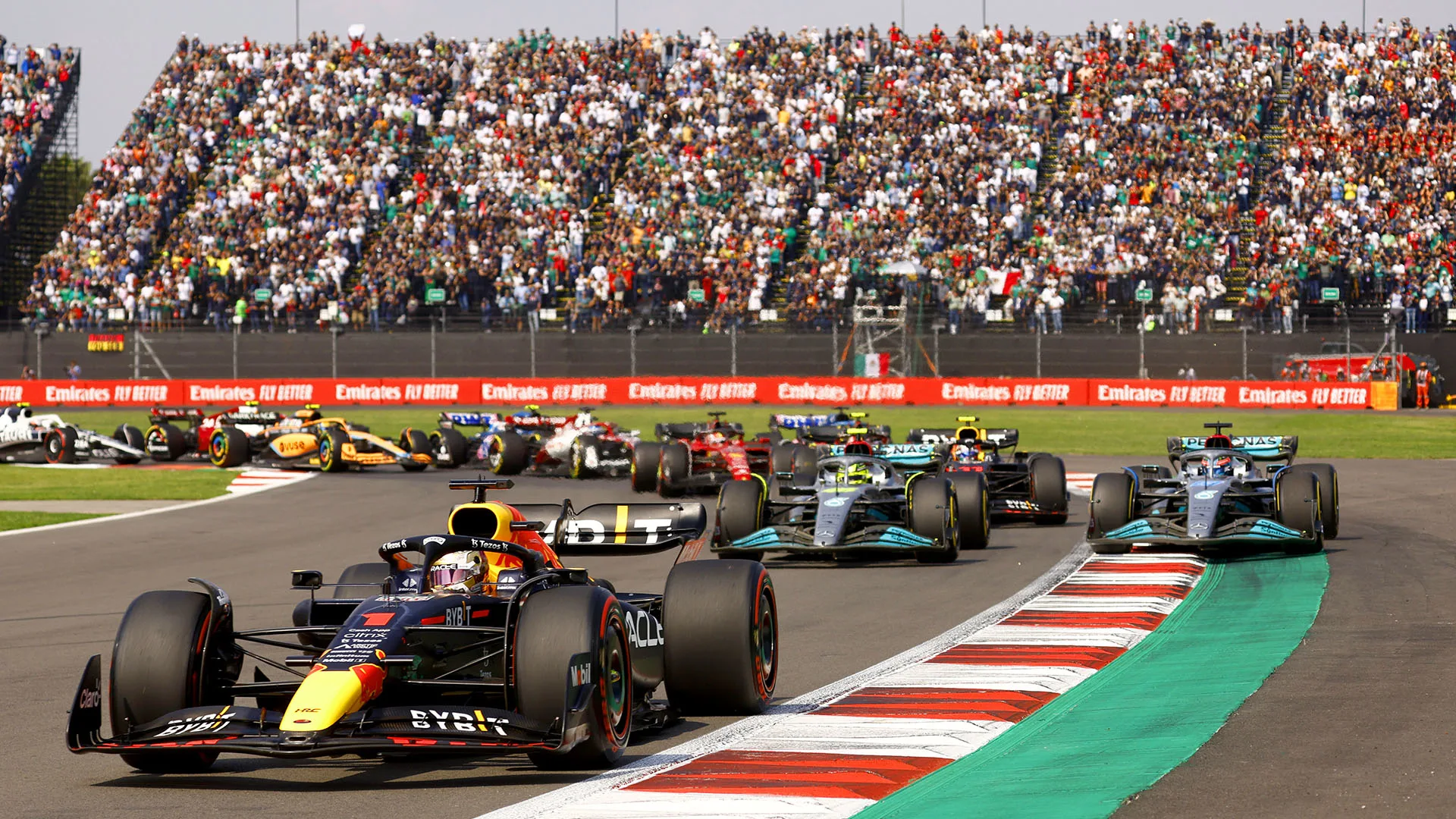F1 – Are you a fan of adrenaline-pumping action, breathtaking speed, and cutting-edge technology? Do you love watching the world’s best drivers push themselves and their machines to the limit ?
Do you want to learn more about the history, structure, success factors, and future of the most prestigious and exciting motorsport in the world?
If you answered yes to any of these questions, then you are in the right place. Welcome to Formula 1 (F1), the ultimate racing challenge. F1 is the highest class of international racing for open-wheel single-seater formula racing cars. It is sanctioned by the Fédération Internationale de l’Automobile (FIA).
It is widely regarded as the pinnacle of motorsport, attracting millions of fans and sponsors around the world.
- But what makes F1 so successful and appealing?
- How does it operate today?
- And what are the factors that determine its success?
In this article, we will answer these questions and more, as we explore the fascinating world of F1.
The History of F1
F1 traces its roots back to the pre-war Grand Prix racing, which featured races between various national teams representing different car manufacturers.
After World War II, the FIA decided to create a new set of rules for a World Championship of Drivers, which would be based on a formula of engine capacity and weight.
The First F1 Race Was Held In 1950
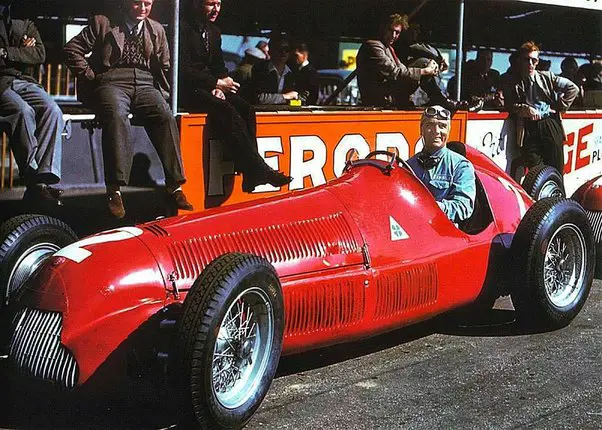
The first Formula 1 season was held in 1950 at the Silverstone racing track in the United Kingdom. There were seven races across Europe and one in the United States. The first F1 champion was Giuseppe Farina, driving for Alfa Romeo.
Since then, F1 has evolved and expanded to become a global phenomenon. Races are held on six continents and feature drivers and teams from various countries and backgrounds.
F1 has also seen many changes in its regulations, technology, safety, and governance over the years. It is constantly adapting to the challenges and opportunities of each era.
F1 Milestones
Some of the most notable milestones in F1 history include:
- The introduction of the Constructors’ Championship in 1958, which awarded points to the teams based on their drivers’ results.
- The emergence of Lotus as a dominant force in the 1960s. This was thanks to its innovative designs and use of aerodynamics, monocoque chassis, and rear-engine layout.
- The massive improvements in safety.
- The rise of Ferrari as a legendary team in the 1970s. This was led by its charismatic founder Enzo Ferrari and its star drivers such as Niki Lauda and Gilles Villeneuve.
- The dominance of McLaren and Williams in the 1980s and 1990s. It featured some of the greatest rivalries and battles in F1 history, such as Alain Prost vs Ayrton Senna and Nigel Mansell vs Nelson Piquet.
- The era of Michael Schumacher and Ferrari in the early 2000s. It saw them win five consecutive drivers’ and constructors’ titles from 2000 to 2004. They set new records for wins, poles, podiums, and points.
- The emergence of Red Bull as a new powerhouse in the late 2000s and early 2010s. It propelled Sebastian Vettel to four consecutive drivers’ titles from 2010 to 2013.
- The era of Mercedes and Lewis Hamilton. It saw them win seven consecutive drivers’ and constructors’ titles from 2014 to 2020. They broke many of Schumacher’s records.
The Structure Of F1
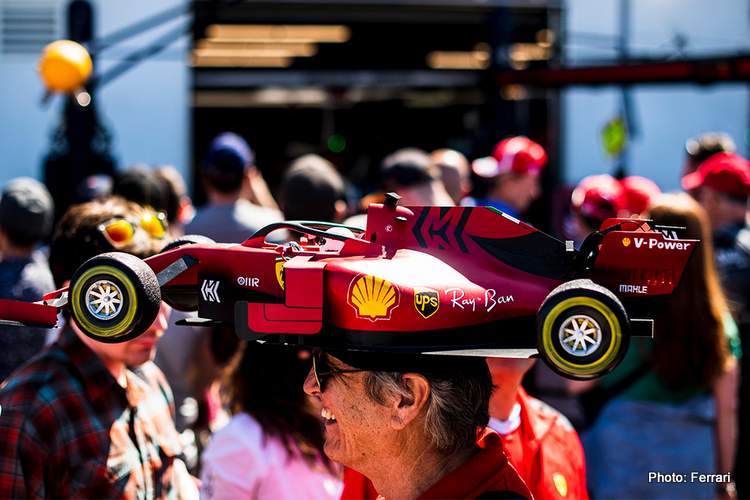
F1 is governed by the FIA, which sets the rules and regulations for the sport. The organization also oversees safety, fairness, and integrity.
The FIA also organizes the FIA Formula One World Championship. This consists of a series of races known as Grands Prix (French for “grand prizes”). Each Grand Prix is held over a weekend, usually from Friday to Sunday. They usually consist of three practice sessions, one qualifying session, and one race.
The FIA Formula One World Championship awards two titles: one for the drivers and one for the constructors.
The Drivers And Constructors Championship
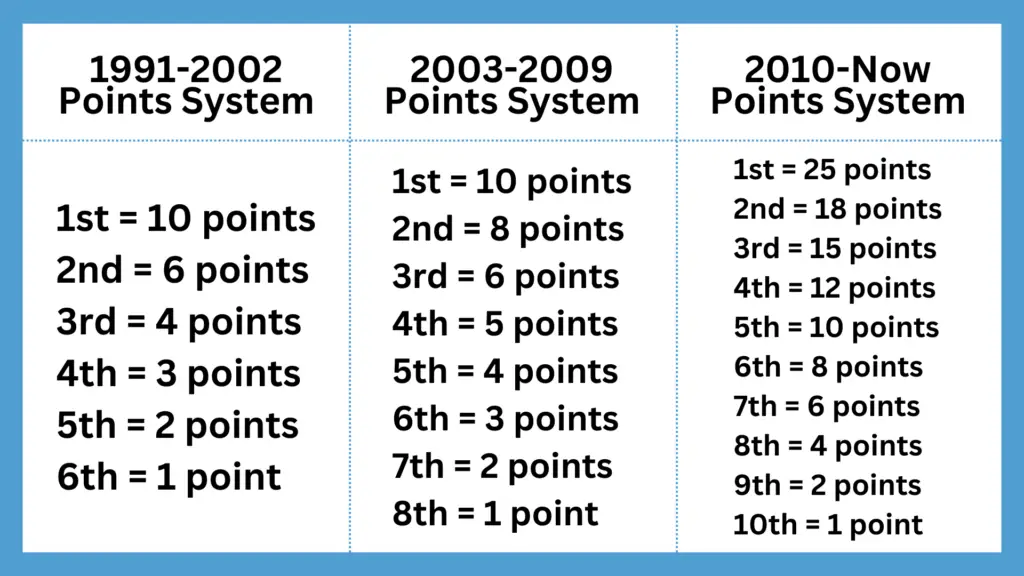
The drivers’ championship is awarded to the driver who scores the most points over the season.
The constructors’ championship is awarded to the team that scores the most points over the season.
The points are awarded based on the finishing positions of each driver in each race.
| Place | Points |
|---|---|
| 1st | 25 |
| 2nd | 18 |
| 3rd | 15 |
| 4th | 12 |
| 5th | 10 |
| 6th | 8 |
| 7th | 6 |
| 8th | 4 |
| 9th | 2 |
| 10th | 1 |
The FIA Formula One World Championship is contested by 10 teams (also known as constructors), each with two drivers.
Each team designs and builds its own car according to the technical regulations set by the FIA. The cars must have a single-seat cockpit with an open-wheel layout (meaning that the wheels are not covered by bodywork).
Each car must also have a hybrid power unit (PU). This consists of a turbocharged internal combustion engine (ICE) and an energy recovery system (ERS).
The ICE provides the main source of power. The ERS recovers and stores energy from the braking and exhaust systems. The drivers can deploy it as an extra boost of power.
Each car must also have the following dimensions.
- A minimum weight of 752 kg (including the driver and fuel)
- A maximum width of 2 m
- A maximum length of 5 m
- A maximum height of 0.95 m.
F1 Structure
The FIA Formula One World Championship is also supported by various partners and stakeholders, as listed below
Formula One Group

The Formula One Group owns the commercial rights to the sport, such as broadcasting, sponsorship, merchandising, and promotion. Formula One Group is owned by Liberty Media, a US-based media conglomerate.
Formula One Management (FOM)

FOM is a subsidiary of Formula One Group. It is responsible for managing and producing the TV coverage of the races.
It also distributes the revenues to the teams and the FIA.
Formula One Teams Association (FOTA)

FOTA is a voluntary association of the teams that represents their interests and negotiates with the FIA and FOM on various matters. These include sporting and technical regulations, the calendar, and the prize money.
Pirelli
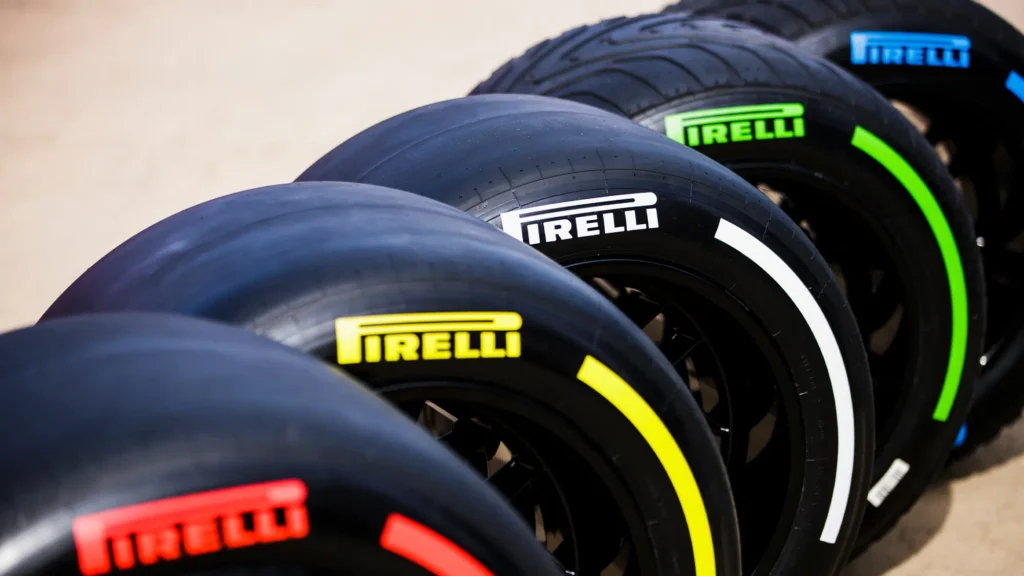
which is the sole tire supplier for F1 since 2011. Pirelli provides each team with a range of tire compounds for each race. These vary in terms of durability and performance.
Each driver must use at least two different compounds during a race, unless it is declared a wet race.
DHL

which is the official logistics partner for F1 since 2004. DHL transports all the cars, equipment, personnel, and materials for each race around the world.
They use a fleet of planes, trucks, and ships.
The F1 Success Factors
F1 is a complex and competitive sport that requires a combination of factors to achieve success. Some of the most important factors are:
The F1 Driver
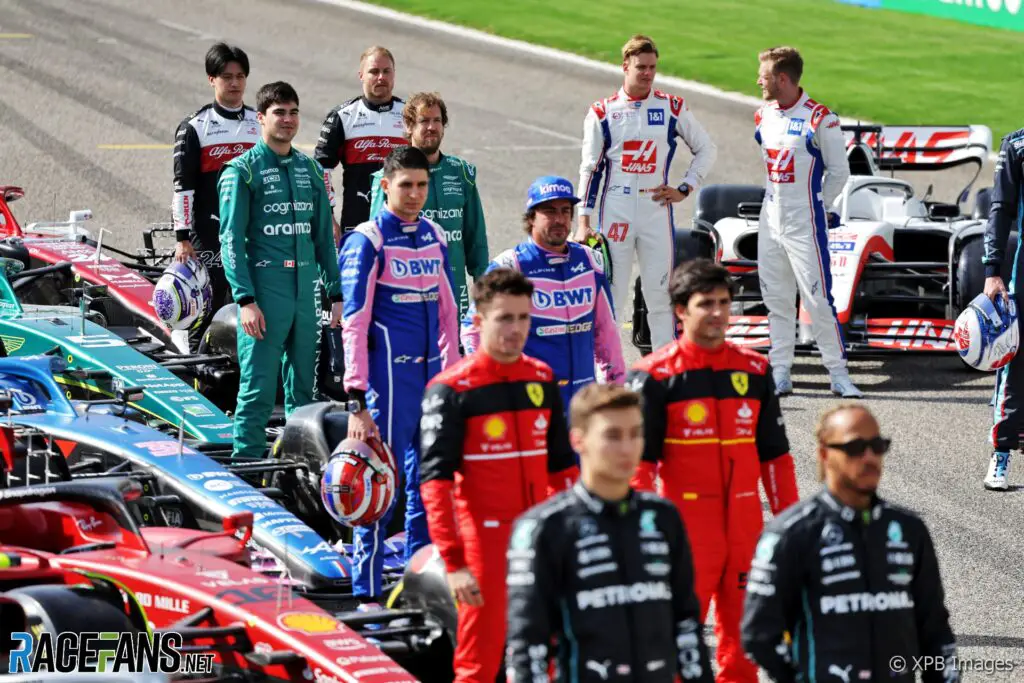
The Formula 1 driver is the one who controls the car on the track, making split-second decisions and executing precise maneuvers.
The driver must have exceptional skills, such as speed, reflexes, concentration, consistency, courage, intelligence, and adaptability.
The F1 driver must also have a good relationship with his team-mate, his engineer, his mechanics, and his team principal.
He must also cope with the physical and mental demands of racing at high speeds for long periods of time. He also has to deal with the pressure and expectations of the media and fans.
The Car
The F1 car is the machine that enables the driver to compete on the track. The car must be designed and built according to the technical regulations set by the FIA.
It must also be reliable, efficient, aerodynamic, fast, stable, and responsive. The car must also suit the characteristics of each track and each tire compound.
It must also be constantly developed and improved throughout the season to keep up with the competition.
The F1 Team
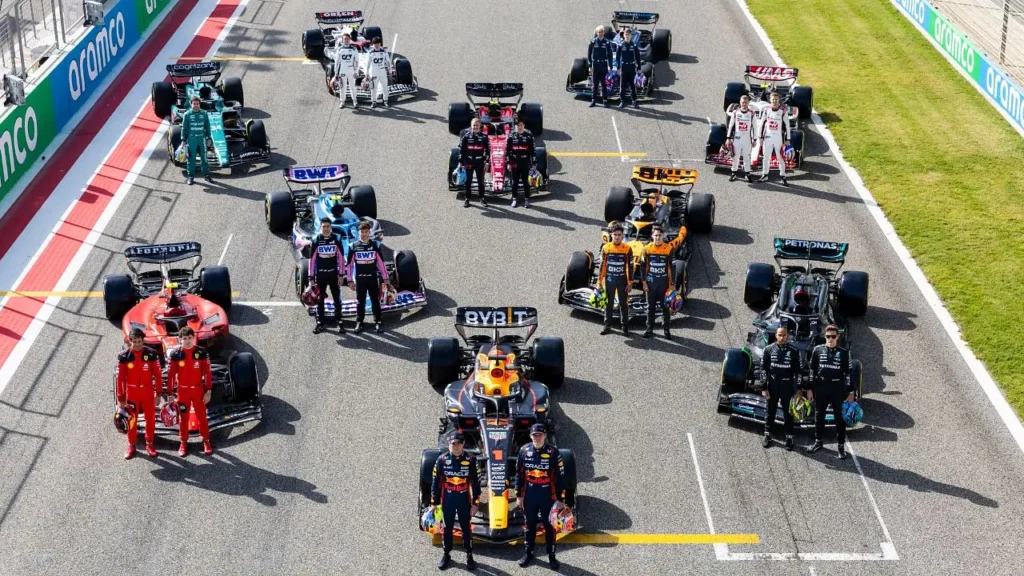
The Formula 1 team is the organization that supports the driver and the car on and off the track. The team consists of various roles and functions, such as:
The Team Principal
The team principal is the leader and manager of the team. He or she is responsible for setting the vision, strategy, goals, budget, and culture of the team.
The principal is also responsible for hiring and firing staff, negotiating contracts with drivers, sponsors, suppliers, and partners. He or she is also responsible for representing the team in front of the media and other stakeholders.
The Technical Director
The technical director is the head of the technical department of the team. He or she is responsible for overseeing all aspects of designing, building, testing, and operating the car. He or she is also responsible for coordinating the technical staff and liaising with the suppliers and partners.
The Race Engineer
The race engineer is the main point of contact between the driver and the team during a race weekend.
He or she is responsible for setting up the car according to the driver’s preferences and the track conditions, as well as providing feedback and advice to the driver during practice, qualifying, and the race.
He or she is also responsible for analyzing the data from the car and communicating with the strategists and other engineers.
The Strategist
The strategist is responsible for planning and executing the optimal race strategy for each driver. He or she must take into account various factors such as tire wear, fuel consumption, pit stops, safety cars, weather, and competitors.
The strategist is also responsible for monitoring the live data from the car and adjusting the strategy accordingly during the race.
The Data Analyst
The data analyst is responsible for collecting and processing the vast amount of data generated by
- The Car’s Sensors.
- Telemetry Systems.
- GPS.
- Weather.
- Timing.
- Track Temperature.
He or she is responsible for providing useful information and insights to the engineers, strategists, and drivers to help them improve their performance and decision making.
The Mechanic
The mechanic is responsible for
- Assembling
- Maintaining
- Repairing
- Adjusting the car’s components and systems.
He or she is also responsible for performing pit stops during the race, which involve changing tyres, refuelling, adjusting wings, and fixing any damage.
Each mechanic has a specific role and position in the pit crew, which requires precision, speed, and coordination.
The Tire Engineer
The Tire Engineer is responsible for managing the team’s allocation of tires for each race weekend. He or she is responsible for
- Selecting
- Preparing
- Heating.
Scraping - Fitting
- Checking.
- Storing the tyres according to the FIA regulations and the team’s strategy.
He or she is also responsible for providing feedback on tire performance and degradation to the engineers and strategists.
The Team At The Factory
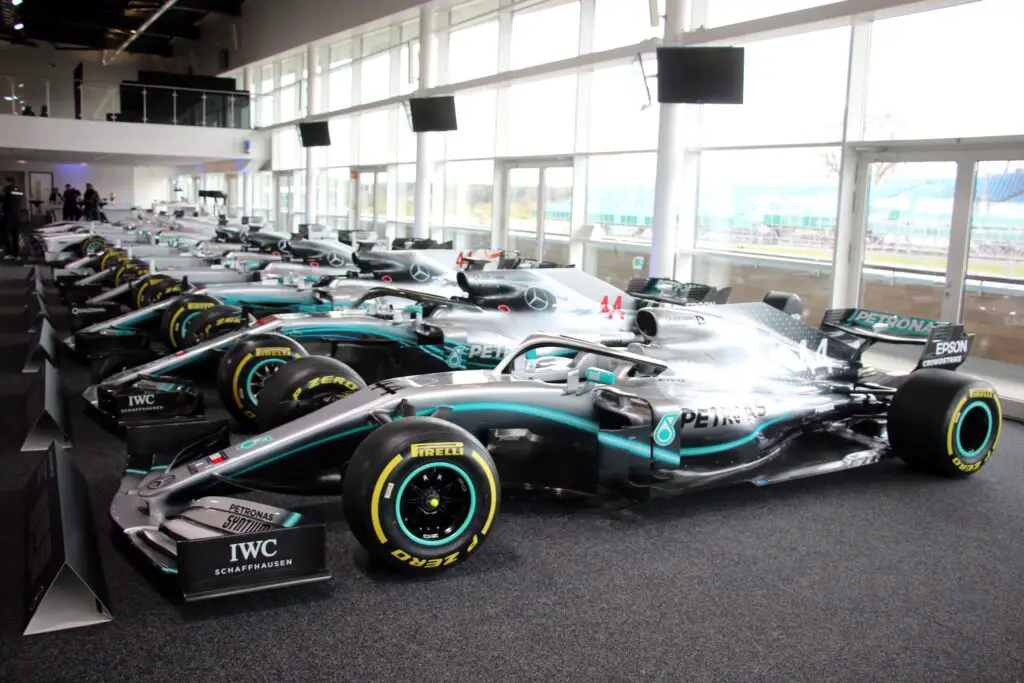
The factory team consists of hundreds of people who work at the team’s headquarters in
- Aerodynamic Engineers
- Design Engineers
- Development Engineers
- Electronic Engineers
- Performance Engineers
- Powertrain Engineers
- Reliability Engineers
- Simulation Engineers
- Testing Engineer
- Manufacturing
- Researchers
- Quality control
- logistics
- Administration
- Finance
- Marketing
- Media relations
- Human resources
- Legal affairs.
The factory team works closely with the race team to provide them with the best possible car and support throughout the season.
The Challenges Of F1
F1 is a highly competitive and demanding sport that poses many challenges to its participants. Some of the most common challenges are:
The Cost Of F1
F1 is one of the most expensive sports in the world, with teams spending hundreds of millions of dollars per year on their operations.
According to Forbes, in 2020 Mercedes spent $484 million to win both titles; Ferrari spent $426 million to finish sixth; Williams spent $132 million to finish last.
The cost of F1 has been a source of controversy and debate for many years. Some teams have struggled to survive financially and others calling for a more level playing field.
In 2021, a new budget cap of $145 million was introduced by the FIA to limit the spending of each team on certain areas such as salaries, travel expenses, research and development, and production.
The cap does not include certain costs such as driver salaries, marketing expenses, engine costs, and heritage activities. The cap will also be adjusted depending on the number of races and the inflation rate. The aim of the cap is to reduce the spending gap between the teams and create a more competitive and sustainable sport.
The Competition
F1 is a highly competitive sport, with 10 teams and 20 drivers fighting for glory and prestige on every race weekend.
The competition is not only on the track, but also off the track, in terms of design, development, innovation, strategy, politics, and media.
The competition is also influenced by various factors such as regulations, technology, resources, luck, and human error. It is also constantly evolving, with new teams, drivers, rules, and challenges emerging every year.
To succeed in F1, a team must be able to adapt and overcome these factors and stay ahead of the curve.
The Environment F1 Operates In
F1 is a sport that operates in a dynamic and complex environment, with various challenges and opportunities arising from different sources. Some of the environmental factors that affect F1 are:
Some of the environmental factors that affect F1 are:
The F1 Circuits
F1 races on a variety of tracks around the world, each with its own characteristics and challenges.
Some tracks are permanent circuits, such as Silverstone or Monza; some are street circuits, such as Monaco or Singapore; some are hybrid circuits, such as Melbourne or Baku.
Each track has different layouts, lengths, corners, elevations, surfaces, grip levels, tire wear rates, overtaking opportunities, and safety features.
The different circuits also have varying weather conditions, such as temperature, humidity, wind, rain, and sun. Each track requires a different set-up for the car and a different strategy for the race.
The F1 Fans
F1 has a huge and passionate fan base around the world. There are millions of people watching and following the sport on various platforms across all age groups, genders, nationality, cultures, and preferences.
The fans are also vocal and influential in terms of expressing their opinions and feedback on various aspects of the sport.
F1 fans are also loyal and supportive of their favorite teams and drivers. F1 fans are a vital part of the sport’s success and growth.
Reducing Pollution An Increasing Sustainablity
F1 has set a goal to be fully carbon neutral by 2030. Read how they plan to do this in the following article Link.

